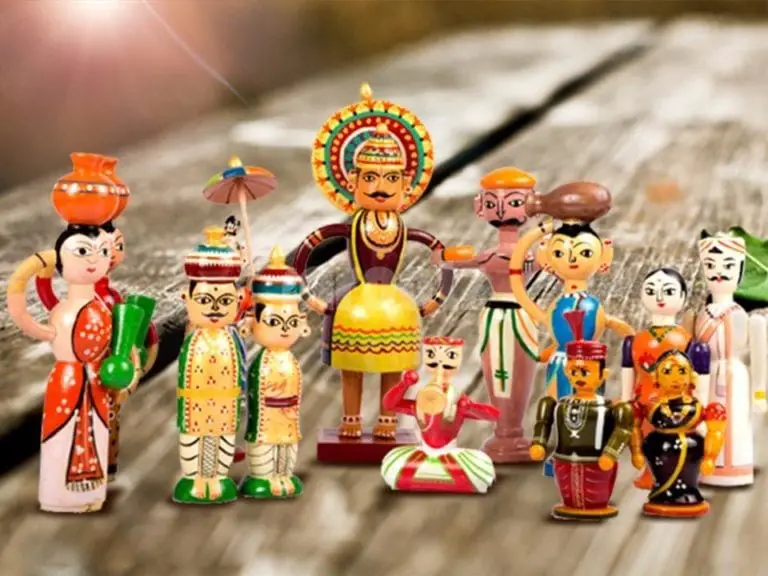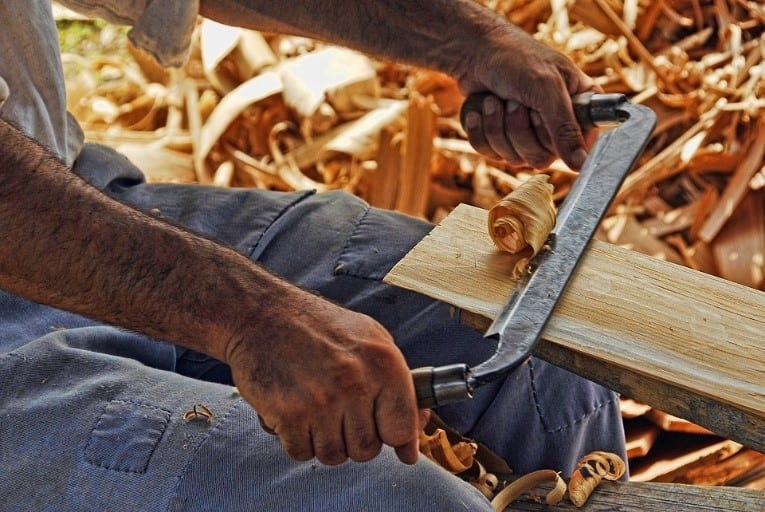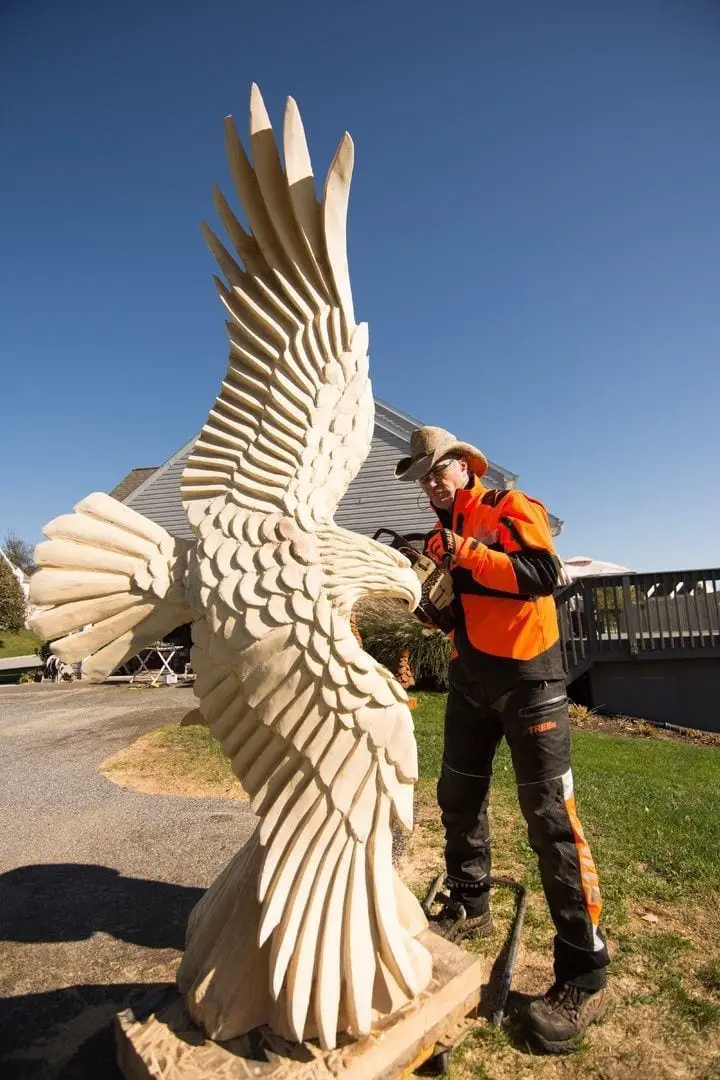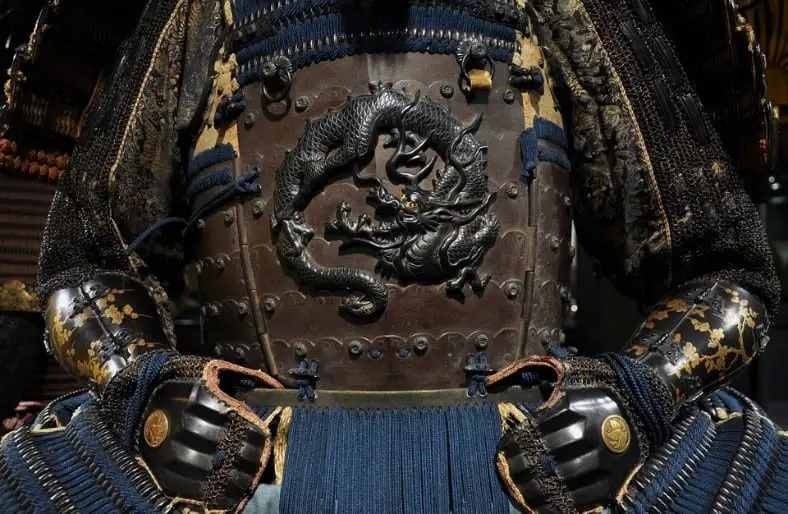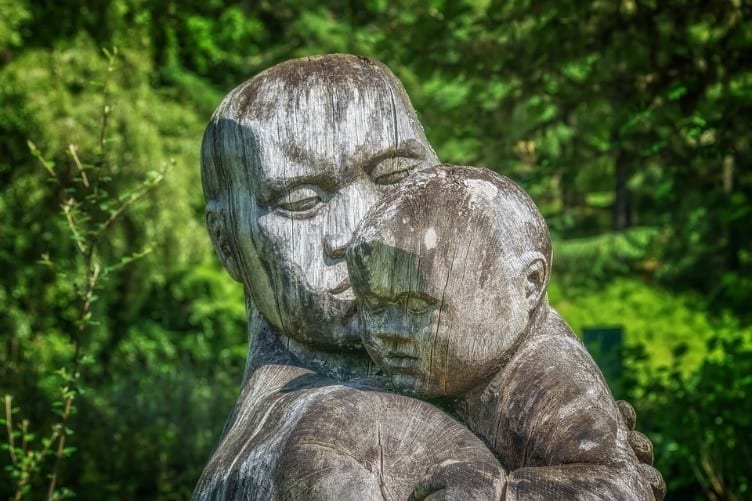As soon as you hold a Channapatna toy in your hands, all your worries seem to disappear. For a brief momentum, you may simply forget about single care in the world, enchanted by the captivating magic of the handcrafted Indian toys.
And indeed, the vivid, colorful toys are made solely and exclusively by hand.
Ultimately, these toys are also made out of 100% natural materials.
Apart from wood which is the most important material in the process of making the amazing toys, the dyes used for coloring are obtained from only natural sources, without a single trace of any synthetics.
It is surely no wonder why these incredible toys have earned the town of Channapatna the nickname “Toy Town” (“Gombegala Ooru”) of Karnataka State.
Video by National School of Journalism – Channapatna – The Toy Town
Channapatna Toys: The Beginning
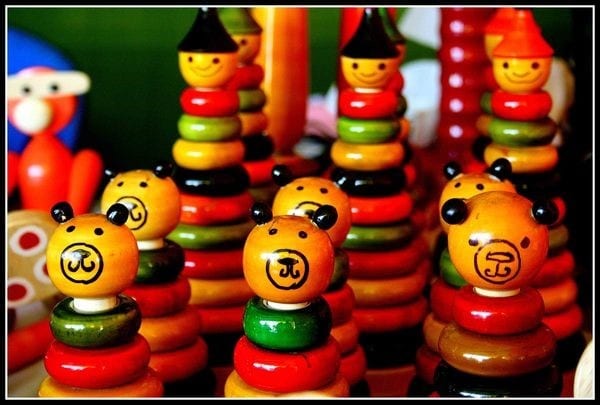
The origin of Channapatna toys can be traced back to the reign of Tipu Sultan who ruled the country from 10 December 1782 to 5 May 1799.
Interestingly, Tipu Sultan introduced a large number of innovations, one of which includes a new lunisolar calendar. This calendar is rather intriguing and no less complex as itevolves around tracingplanetary motion.
Video by Kishore Kumar – Hindu Lunisolar Calendar
When it comes to the wooden lacquer ware toys that gradually turned into one of the hallmarks of the Karnataka district, Tipu Sultan decided to invite artisans from Persia who possessed intricate skills in the making of wooden toys.
The Sultan was so impressed by a wooden toy he received as a gift that he eagerly wanted to introduce the amazing craft in India, too.
Tipu Sultan asked the gifted Persian artisans to train the local Indian artisans in the secrets of crafting the incredible toys.
Thus, it is only fair to state that the art of making wooden lacquer toys is deeply rooted in ancient Persian art.
But most noteworthy, it was thanks to the Indian wooden toymakers that the Persian craft was kept alive for over two centuries.
On another note, it is not Tipu Sultan but Bavas Miyan who is widely referred to as the father of Channapatna toys.
It was Bavas Miyan who perfected the design of the wooden lacquer toys by incorporating Japanese techniques that further enriched the craft.
As a result, Bavas Miyan helped the local people of Channapatna to significantly improve their art.
Reviving the Ancient Craft of Making Wooden Lacquer Toys in India
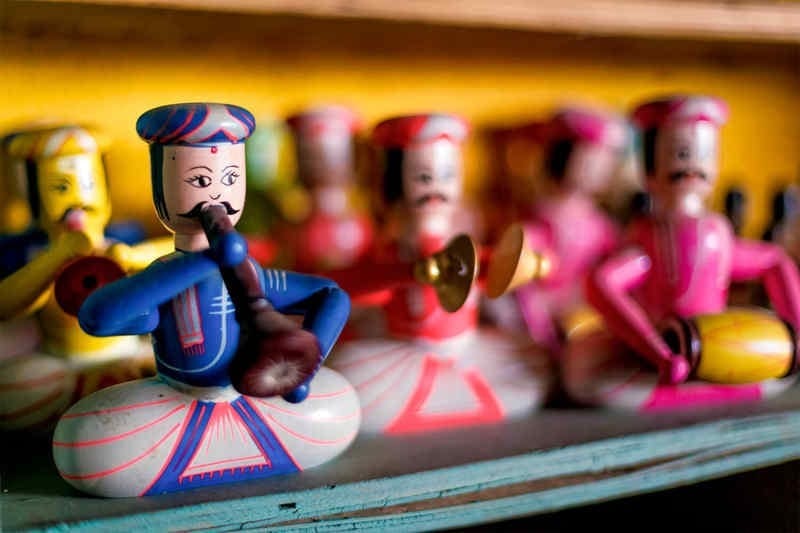
Despite the beautiful progress of the Indian craft of making wooden lacquer ware toys during the course of the 18th century, there was a certain period in history when toy industry in the region was faced with the threat of extinction.
According to a detailed summary of Channapatna toys by Azmathulla Shariff titled Toy town changes with new trends, there was agreat pressure faced by the toy industry in the 21st century.
Due to a financial crunch, the local artisans involved in the process of making Indian wooden lacquer ware toys were on the very brink of watching their craft slowly die out.
The financial crisis lasted for approximately a decade.
Fortunately, thanks to Karnataka Handloom Development Cooperation (also known as KHDC), the craft was successfully revived.
Nevertheless,thetraditional craft was further protected by the World Trade Organization after being listed as a geographical indication (also referred to by the acronym GI).
The Geographical Indication is a name or a sign that is used only on certain products. It signifies that the product is made by following and applying traditional methods.
Also, GI acts as a certification to indicate that a particular product is unique for its geographical origin and/or one-of-a-kind qualities.
Video by Idle Bees – What is Geographical Indication ( G I ) ?
Furthermore, Karnataka Government has also provided tremendous help for the sake of reviving the traditional craft of the region. On the one hand, a Lacquerware Craft Complex in Channapatna was constructed.
On the other hand, together with financial help from the Dutch Government, the Karnataka Government laid the groundings of the Vishwa scheme – a program created to provide financial support to the local artisans.
Little by little, the ancient craft was brought back to life.
Keeping in mind the need of making the Indian toys appealing to modern-day society, master craftsmen introduced trendy prototypes designs to the local artisans.
These designs were set to make the art of crafting wooden lacquer toys right in the spotlights of the new century.

Handmade coasters are becoming very popular in the art of making Indian wooden lacquer toys – Image Source
Thus, much more sophisticated and contemporary toys started to emerge. Some of these include puzzles, as well as home décor items such as storage jars, among others.
But above all, the soul of the ancient craft remains the same, for these charming little treasures are born to bring people happiness and joy.
Video by Bois Guilo – When design meets lacquerware in Channapatna
Behind the Scenes of Making Indian Wooden Lacquer Ware Toys

As briefly mentioned above, Channapatna toys are eco-friendly since they are crafted with the use of 100% natural materials.
Ultimately, the craft has diversified throughout the course of history, and this isn’t solely related to the regular introduction of new, trendy designs that make the toys appealing to a broader public worldwide.
Many artisans use wood obtained from a local tree known as Haale Mara (Wrightia Tinctoria).
Wrightia Tinctoria trees provide a wonderful type of timber for the production of Indian wooden lacquer ware toys as the wood is characterized as rather soft.
Thus, it is not suitable for the production of furniture but is a fantastic alternative when it comes to the traditional handicraft of Channapatna.
Video by Media Space – Sweet Indrajao Wrightia tinctoria
Another amazing use of Wrightia Tinctoria trees extends beyond the ancient Indian craft. Wrightia Tinctoria extract is believed to help cure psoriasis.
Meanwhile, other types of wood used for making the cheerful Indian wooden lacquer toys include ivory-wood, sycamore, cedar, teak, pine, and rubber.
Above all, it is the local families that make the backbone of the amazing Channapatna handicraft.
According to statistics from 2006, a whopping 254 of all manufacturing units in Channapatna were home manufacturing units while the number of factories was estimated at 50.
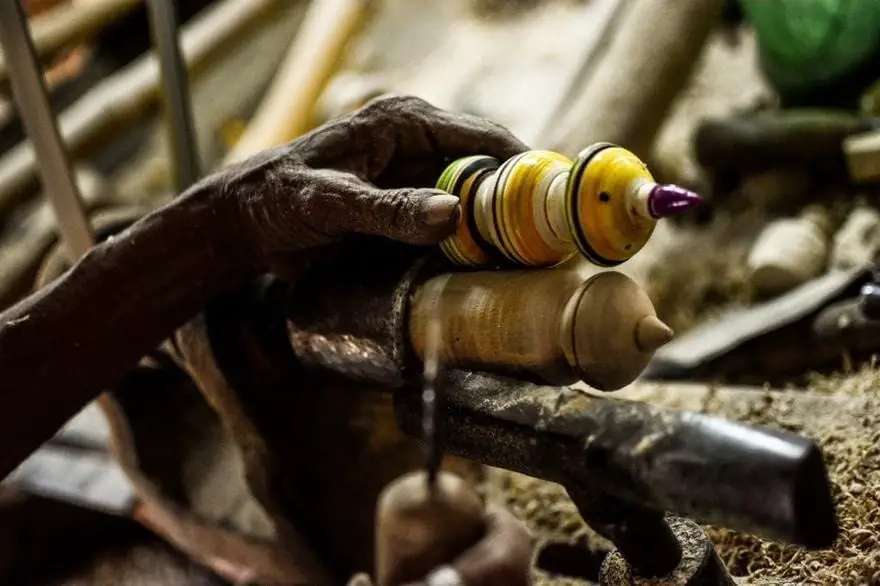
For a start, wood has to be carefully dried until any traces of moisture are removed. The time needed for this process to be accomplished varies depending on the type of wood.
For instance, with Wrightia Tinctoria, the drying time is approximately two months.
Next, the wood is chopped down into blocks. These blocks don’t need to be perfectly even as this is irrelevant for the process of making the incredible wooden lacquer toys of Channapatna.
It is by the hands of the skillful craftsmen that the unevenly-shaped blocks of wood gradually take on shape, as well as meaning.

Finally, a thin layer of lacquer is spread until the toys end up with a distinctly glossy, dazzling finish. The lacquer is created with the use of all natural dyes.
For instance, turmeric is used for yellow coloring and vermillion is used for red coloring. Nevertheless, indigo is used for blue coloring.
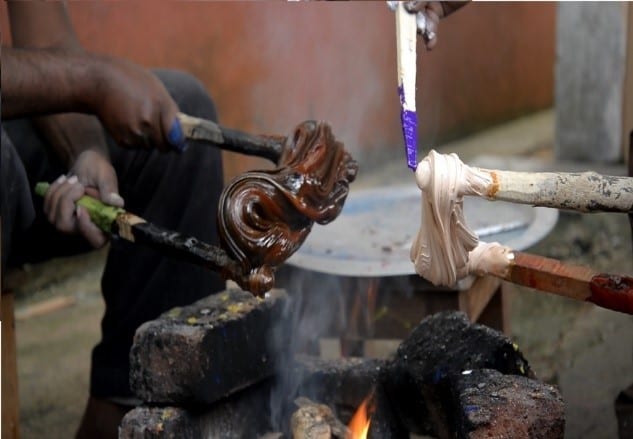
Video by WoodCulture – Art & Joy of Wood: Indian Wooden Lacquer Ware Toys
Cutting,chiseling and lacquering can proceed from dusk till dawn.
Despite the dust and noise, the dedicated Indian craftsmen families work with a contagious passion for their craft.
Not only is the production of Indian wooden lacquer ware toys a source of joy for the artisans but it is also bringing the families great hopes for the future. These hopes are not related to becoming rich but instead, to being able to raise their kids and make sure they can get well-educated.
The Challenges of the 21st Century: Will the Heart-Warming World of Traditional Handicrafts Win the Battle with Modernization?

Just about a decade ago, the ancient craft of Channapatna toy making was faced with an unbeatable and uneven competitor – China.
As the machine-made, cheap Chinese toys flooded the local markets, the Indian toy makers engaged in the making of the cheerful wooden lacquer ware toys became terribly desperate.
After all, how could they possibly compete with the inexpensive production of the Chinese toy factories?
Fortunately, the situation swiftly improved as if by a miracle.
Due to the fact that the Chinese toys were made with the use of toxic dyes as well as rather cheap and often unknown materials, they were deemed unsuitable for children in terms of safety.
On another note, tremendous efforts have been put by different social enterprises and many new companies in order to popularize the beautiful craft of Channapatna.
In fact, a group formed by Bharath Art and crafts – iFolk Channapatna toys and handicrafts – works for supporting and promoting Channapatna artisans to do further innovations and modernization to their products.
In 2010 Michelle Obama bought some of the adorable wooden lacquer toys during her visit to India. Mrs. Obama got her tiny collection of toys from the National Handicrafts and Handloom Museum in New Delhi.
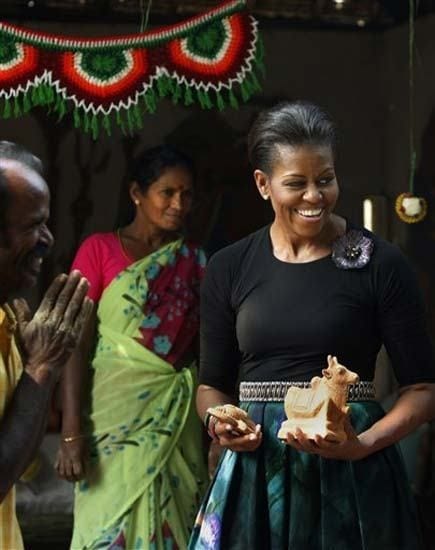
This seemingly small gesture turned out to work amazingly for promoting the Channapatna toys handicraft. Gradually, various countries all over the world – but especially Japan and the USA – became loyal fans (and, of course, customers), of the ingenious wooden lacquer ware toys.
However, there is yet another challenge that threatens the ancient art of Channapatna toy making – the local artisans find it harder than ever to transmute the secrets of the craft to the next generations.
But why is this happening?

An increasing number of young Indians are looking for a better future in the big cities. A high level of education cannot be possibly attained in the small village of Channapatna. Nevertheless, big cities allure adolescents with the promise of eventually being able to get employed easily by large companies.
Indeed, both education and employment are extremely important to ensure better days for India and it is only the young generations that can make this change happen.
Unfortunately, if the tendency mentioned above continues, the traditional Indian craft marked by generations of Channapatna artisans may completely die out during the next decades.
Video by likitha prakash – channapatna wooden toys
Final Food for Thought

In a world that is evolving with a pace faster than ever before, handicrafts are becoming increasingly important for preserving the rich cultural heritage of different nations globally.
The process of making Indian wooden lacquer ware toys can make one sink into another reality – a reality that is marked by the heart-warming traditions of the ancient handicrafts.
Mesmerizingly beautiful and eco-friendly, Channapatna toys speak a language that knows no limit.
Showcasing the stunning diversity of the endless creativity and love for the craft that flow through the minds and the hearts of the toymakers, the dazzling little toys of Channapatna are not just another fancy trend.
Instead, each toy is a tiny piece of happiness that someone, somewhere, sometime has created so that someone, somewhere sometime…can find a reason to smile.

Help us spread the word for the incredible wooden lacquer ware toys with the world by sharing this article.
“The wood-carver can fashion whatever he will. Yet his products are but toys of the moment, to be glanced at in jest, not fashioned according to any precept or law. When times change, the carver too will change his style and make new trifles to hit the fancy of the passing day. But there is another kind of artist, who sets more soberly about his work, striving to give real beauty to the things which men actually use and to give to them the shape which tradition has ordained. This maker of real things must not for a moment be confused with the maker of idle toys.”
― Murasaki Shikibu, The Tale of Genji
